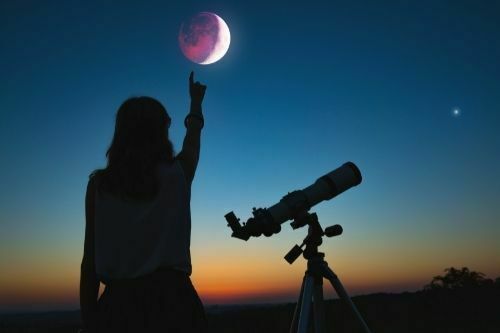Table of Contents
Astronomy has a long and diverse history and has evolved to become a field that studies the sun, moon, stars, different planets, and other interstellar objects and phenomena.
With the science of astronomy, there have been significant insights to our understanding of the vast space beyond the Earth’s atmosphere. Astronomy combines several disciplines such as celestial & fluid mechanics, data science, mathematics, advanced electronics, and positional astronomy.
The night sky has unfathomable depths and secrets that continue to unravel with emerging discoveries. The vastness of the universe is one that continues to be explored and appreciated, bringing forth new information about how space came to be.
Keep reading to discover 25 amazing astronomy facts that will leave you spellbound!
25 Astronomy Facts You Should Know!
- The radio signal that a spacecraft uses to contact Earth has less power than a refrigerator light bulb! By the time the signal travels across space and reaches Earth, it is only ‘one-billionth of the one-billionth of 1 Watt!’
- Research estimates that more than 1300 Earths can easily fit into Jupiter’s vast sphere. That’s how big the king of the solar system is!
- Staying true to its namesake (The name Mercury is after the Roman god of messengers), Mercury is the fastest planet in the entire solar system! It zips around the sun at an average speed of 107,000 miles an hour.
- All research and evidence collected, point to the fact that the solar system is approximately 4.5 billion years old.
- The hottest planet in the solar system is Venus. Temperatures on the surface of Venus reach a whopping 880oF (471oC) during the day.
- Light-year is a unit of measurement to measure the distance between different celestial objects. One light-year is equal to about 6 trillion miles (9 trillion kilometers)!
- Dark matter is a new discovery. It is a mass that does not emit any energy or light and accounts for as much as 27% of the entire universe.
- Dark energy, on the other hand, is a mysterious force that causes the rate of expansion of the universe to accelerate over time. Dark energy accounts for 68% of the universe’s total energy!
- The asteroid belt is a region within the solar system that is located between the orbits of Mars and Jupiter. The entire mass of the asteroid belt is just 3% of the total mass of the moon! This is an astronomy fact that has revolutionized our understanding of these celestial objects.
- Saturn may be the second-largest planet in our solar system, but it is less dense than water! The planet is 96% hydrogen. It would float if you could build a bathtub big enough for Saturn!
- The Milky Way is our home galaxy and estimates to contain more than 100 million stars!
- The number of observable galaxies in the universe is only 125 billion.
- Neutron stars are one of the most fascinating astronomical objects. These stars are composed of neutrons packed together into a tiny radius. They are the densest class of objects and weigh 1.4 times the mass of our sun.
One teaspoon of neutron star material would weigh more than one trillion kilograms! This is one of the astronomy facts that may be beyond comprehension.

- One day on Mercury lasts 59 Earth days, while a year on Mercury lasts 88 Earth days!
- Did you know that Neptune has only completed one orbit around the sun since it was discovered? It takes the planet a whopping 165 years to complete an entire revolution around the sun. Discovered in 1846, the first full orbit was completed in the year 2011.
- NASA’s Voyager 1 is a spacecraft that was launched in 1977. In 2012, nearly 3 decades later, it became the first manmade object to enter interstellar space. Interstellar space is the space beyond the heliopause (the boundary beyond which the majority of the sun’s magnetic field and ejected particles dissipate).

- Neptune’s winds are considered the fastest in our solar system!
They reach an astonishing 2575 kilometers an hour! - A day on Venus is approximately 243 Earth days long. The astonishing astronomy fact, however, is that a day on Venus is longer than an entire year on the planet!
- The sun has been shining for approximately 4.6 billion years! Made of dense gas (mostly ionized helium and ionized hydrogen) the sun constitutes 99% of the entire solar system’s mass!
- Olympus Mons is the tallest mountain in the entire solar system. The peak alone is 16 miles (25 kilometers) high, 3 times taller than Mount Everest!
- The sun loses a billion kilograms of matter every second! The particles of the sun’s upper atmosphere are so energetic and hot that they are shed into space as the solar wind.
- Uranus is the only planet in the solar system that spins on its side – much like a ball rolled around the sun! This tilt causes some of the most extreme seasons in the entire solar system.
- With the Event Horizon Telescope, scientists captured the first image of a black hole in the history of astronomy. It is 3 million times the size of the Earth and is located at the center of the Messier-87 galaxy, 50 million light-years away!
- Our days on Earth are getting longer! The Earth’s spin speed is slowing by 1/500th of a second every year. This means that in 1000 years, one day on Earth will be two-hundredths of a second longer than it is today.
- The atmospheric pressure on Venus is 92 times the Earth’s atmospheric pressure!
Key Takeaways
- Astronomy is a discipline that deals with the study of the universe. It is focused on phenomena, objects, and events that originate outside of the Earth’s atmosphere.
- Several advances in astronomy have led to a combined understanding of the universe as we know it today.
- If you are someone who enjoys learning about the mysteries of interstellar space, the 25 facts will fuel your curiosity!
FAQs
Q1. What is optical astronomy?
Answer – Optical astronomy is the study of different celestial objects in visible light and by using telescopes.
Q2. If the universe is expanding, does that mean our galaxy is also moving?
Answer – Yes! Our Milky Way galaxy zips through space at a rate of 872,405 miles an hour.
Q3. How far is Voyager 1 right now?
Answer – Voyager 1 is the most distant man-made object, located around 14.2 billion miles (22.8 billion kilometers) away from the sun.






